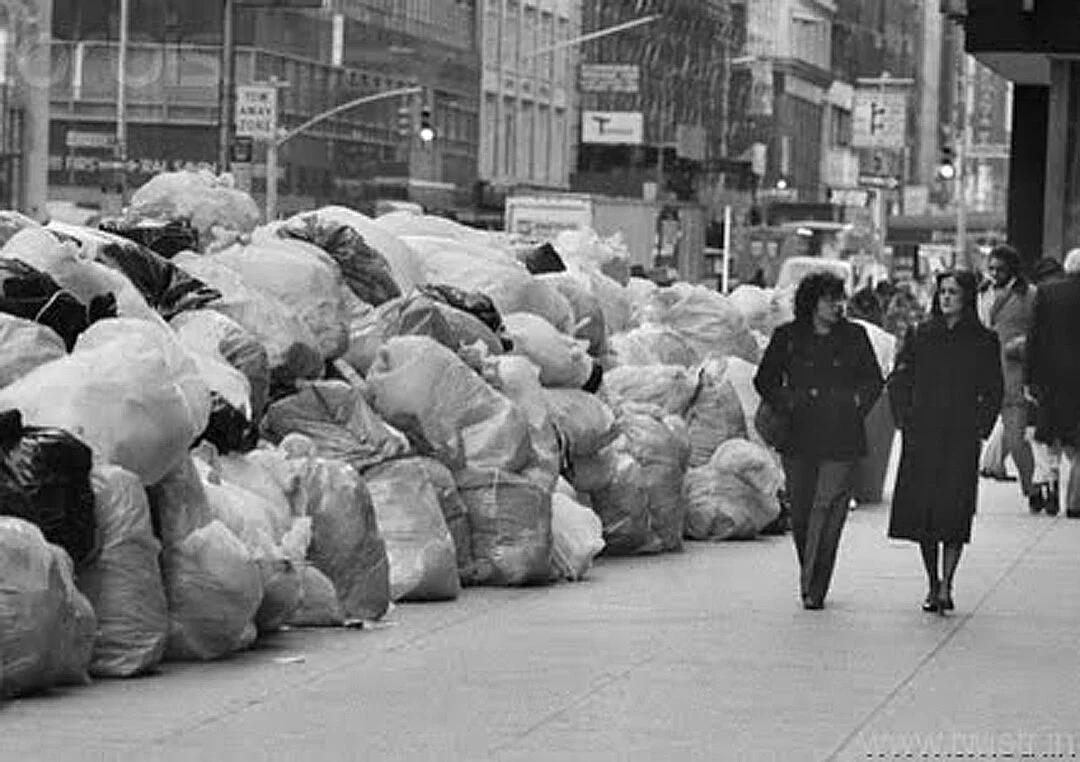When TVs were air conditioners
In 1981, the Sony Trinitron television was as close to the top-of-line as the average American could afford. Big, bright and brilliant, the 27" screen was housed in a plastic shell that must have occupied eight cubic feet. One hundred pounds. Carrying it to a fourth floor walk-up apartment was Sisiphian.
Huge. Heavy. Awesome.
The 1981 New York City sanitation strike
It began just after midnight on December 1. Sixteen days. During that time, garbage piled fifteen feet high. In a city of eight million, where the average citizen smothers the city with over two pounds of trash every day, the resulting mess was unprecedented. The cause is irrelevant. What matters is that rats the size of small dogs were strolling from pile to pile, across five lane avenues, with an impudence usually reserved for a Goldman Sachs partner. The city, at the time, was filthy to begin with, but this was the Sistine Chapel.
New York City — 1981
If you were born after the trash strike or had never visited Manhattan before 1989, its hard to explain how much the city has changed. Street crime was rampant. Hookers plied their trade openly. Muggings were as common as pay phones. Time Square was not the Disneyland that it has since become.
The East Village was, however, amazing. Genius could be found in every club, bar and laundromat. Art of every kind was taking control of everything the pimps couldn’t. It was a flywheel, with chipped teeth, spinning at 6000 rpm. HIV hadn’t been discovered. You could walk into the men’s room of the hippest clubs and watch a profane circus of the absurd, without surprise or irony. Those that didn’t believe in vampires and werewolves were disabused.
Overwhelming stench
There was that moment during the strike—and it was different for every individual—when the trash problem became personal. And, after one had exhausted every personal resource — every hiding spot in one’s apartment, every dumpster on the way to work, every window at the end of the hallway, in every hailed cab, under every parked car, tossed in every open lot, thrown over every razor-wired fence and in every parking structure — one needed to find an alternative.
Becoming ruthlessly practical, parsing the garbage became religious. Rigorous. Analysis. Pyramids are hard to move. Truck tires can be pushed to the end of the block if you can stand them upright. Styrofoam, while bad for the environment, doesn’t attract rats. Banana peels do. A broken TV tray takes up space, but doesn’t reek. Tampons, well.
Never leave a car unlocked in the five boroughs
In Manhattan, even today, a car should never be left unlocked. It will be stolen. With enough time, theft can be guaranteed. Most people understand this fact implicitly, but it bears reminding. An unlocked car is an invitation; a big, fat, beautiful invitation for the underbelly to descend. Distend?
In 1981, ten year-old kids used to bounce down the street testing every car door handle. Stealing pennies from ash trays. And, yeah, there were ten year-old kids wandering the streets all over the five boroughs in 1981.
A big, fat, beautiful invitation
The most gifted creative professional I’ve ever met is truly odd. A college professor who, in his chosen field, was world famous. You would know his work. Unmistakable genius.
Incisive to the extreme, he couldn’t edit himself, sucked his thumb and was stilted in a way that made everybody question themselves. He reached his personal limit with the trash about seven days into the strike. That same day, by coincidence, be bought a new Sony Trinitron.
Roof rack
Collecting the black bile he created over the next several days, he welcomed his neighbors misery, sharing with each his idea. Throwing money at him, they gave him as much garbage as he would take.
He crammed the filth into the Trinitron box, making sure that none of the graphics on the box were covered. Outside, on Bleecker Street, in the West Village, he stumbled until he found a car with a roof rack.
Five minutes later the box was gone.
—

